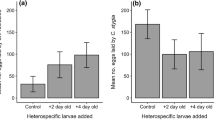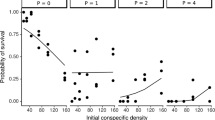Summary
We examined the demographic costs of Chaoborus-induced defensive spine structures in Daphnia pulex. Our aim was to assess the role of resource limitation and the interaction effects of limiting food level and antipredator structures on fitness of D. pulex and to pinpoint those life stages that are most sensitive to changes in the defence regime. Chaoborus-induced and typical morphotypes of D. pulex were reared at high and low food concentrations. Instar-based matrix population models were used to quantify the effects of predator-induction, food and their interaction on fitness of D. pulex. Predator-induction caused a statistically significant reduction in fitness at low food levels, but not at high food levels. Sensitivity analyses revealed that the fitness effects were primarily due to changes in the growth rate in instars 1–5, and secondarily to small reductions in the fertility of instars 5–10. The interaction between Chaoborus exposure and low food concentration was negative, and mediated through growth and fertility components. Both these components were reduced more in the Chaoborus-exposed, low food treatment than would be expected in the absence of interaction.
Similar content being viewed by others
References
Adler FR, Harvell CD (1990) Inducible defenses, phenotypic variability and biotic environments. Trends Ecol Evol 5:407–410
Black AR, Dodson SI (1990) Demographic costs of Chaoborus-induced phenotypic plasticity in Daphnia pulex. Oecologia 83:117–122
Caswell H (1982) Stable population structure and reproductive value for populations with complex life cycles. Ecology 63:1223–1231
Caswell H (1988) Approaching size and age in matrix population models. In: Ebenman B, Persson L (eds) Size-structured populations. Springer, Berlin, pp 85–105
Caswell H (1989a) The analysis of life table response experiments I. Decomposition of treatment effects on population growth rate. Ecological Modelling 46:221–237
Caswell H (1989b) Matrix population models: construction, analysis, and interpretation. Sinauer Associates, Sunderland
Charlesworth B (1980) Evolution in age structured populations. Cambridge University Press, Cambridge
Coley PD, Bryant JP, Chapin FS III (1985) Resource availability and plant antiherbivore defense. Science 230:895–899
Dodson SI (1989) The ecological role of chemical stimuli for the zooplankton: predator-induced morphology in Daphnia. Oecologia 78:361–367
Edgington ES (1987) Randomization tests. Second edition. Marcel Dekker, New York
Gilbert JJ, Stemberger RS (1984) Asplanchna-induced polymorphism in the rotifer Keratella slacki. Limnol Oceanogr 29:1309–1316
Gulmon SL, Mooney HA (1986) Costs of defense and their effects on plant productivity. In: Givnish TJ (ed) On the economy of plant form and function. Cambridge University Press, Cambridge, pp 681–698
Harvell CD (1984) Predator-induced defense in a marine bryozoan. Science 224:1357–1359
Harvell CD (1986) The ecology and evolution of inducible defenses in a marine bryozoan: cues, costs, and consequences. Am Nat 128:810–823
Harvell CD (1990) The ecology and evolution of inducible defenses. Quart Rev Biol 65:323–340
Havel JE (1985) Cyclomorphosis of Daphnia pulex spined morphs. Limnol Oceanogr 30:853–861
Havel JE (1987) Predator-induced defenses: a review. In: Kerfoot WC, Sih A (eds) Predation: direct and indirect impacts on aquatic communities. University Press of New England, Hanover, pp 263–278
Havel JE, Dodson SI (1984) Chaoborus predation on typical and spined morphs of Daphnia pulex: behavioral observations. Limnol Oceanogr 29:487–494
Havel JE, Dodson SI (1987) Reproductive costs of Chaoborus-induced polymorphism in Daphnia pulex. Hydrobiologia 150:273–281
Hrbáčková_esslová M (1963) The development of three species of Daphnia in the surface water of the Slapy Reservoir. Int Rev Gesamten Hydrobiol 48:325–333
Ketola M, Vuorinen I (1989) Modification of life-history parameters of Daphnia pulex Leydig and D. magna Straus by the presence of Chaoborus sp. Hydrobiologia 179:149–155
Krueger DA, Dodson SI (1981) Embryological induction and predation ecology of Daphnia pulex. Limnol Occeanogr 26:219–223
Lande R (1982) A quantitative genetic theory of life history evolution. Ecology 63:607–615
Levin LA, Caswell H, DePatra KD and Creed EL (1987) The life table consequences of larval development mode: an intraspecific comparison of planktotrophy and lecithotrophy. Ecology 68:1877–1886
Lively CM (1986) Competition, comparative life histories, and maintenance of shell dimorphism in a barnacle. Ecology 67:858–864
Meyer JS, Ingersoll CG, McDonald LL, Boyce MS (1986) Estimating uncertainty in population growth rates: jackknife vs. bootstrap techniques. Ecology 67:1156–1166
Neill WE (1978) Experimental studies on factors limiting colonization by Daphnia pulex Leydig of coastal montane lakes in British Columbia. Can J Zool 56:2498–2507
Noreen EW (1989) Computer-intensive methods for testing hypotheses. Wiley, New York
Parejko K, Dodson S (1990) Progress towards characterization of a predator/prey kairomone: Daphnia pulex and Chaoborus americanus. Hydrobiologia 198:51–59
Riessen HP, Sprules WG (1990) Demographic costs of antipredator defenses in Daphnia pulex. Ecology 71:1536–1546
Schultz JC (1988) Plant responses induced by herbivores. Trends Ecol Evol 3:45–49
Simms EL, Rausher MD (1987) Costs and benefits of plant resistance to herbivory. Am Nat 130:570–581
Spitze K (1985) Functional response of an ambush predator: Chaoborus americanus predation on Daphnia pulex. Ecology 66:938–949
Stemberger RS (1988) Reproductive costs and hydrodynamic benefits of chemically induced defenses in Keratella testudo. Limnol Oceanogr 33:593–606
Vuorinen I, Ketola M, Walls M (1989) Defensive spine formation in Daphnia pulex Leydig and induction by Chaoborus crystallinus De Geer. Limnol Oceanogr 34:245–248
Walls M, Ketola M (1989) Effects of predator-induced spines on individual fitness in Daphnia pulex. Limnol Oceanogr 34:390–396
Waris H (1953) The significance for algae of chelating substances in the nutrient solution. Physiol Plant 6:538–543
Zar JH (1984) Biostatistical analysis, second edition. Prentice Hall, New Jersey
Author information
Authors and Affiliations
Rights and permissions
About this article
Cite this article
Walls, M., Caswell, H. & Ketola, M. Demographic costs of Chaoborus-induced defences in Daphnia pulex: a sensitivity analysis. Oecologia 87, 43–50 (1991). https://doi.org/10.1007/BF00323778
Received:
Accepted:
Issue Date:
DOI: https://doi.org/10.1007/BF00323778




